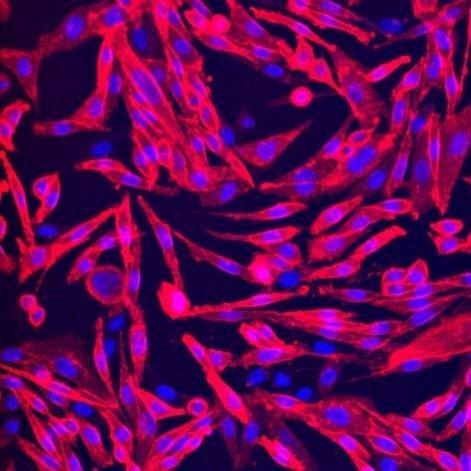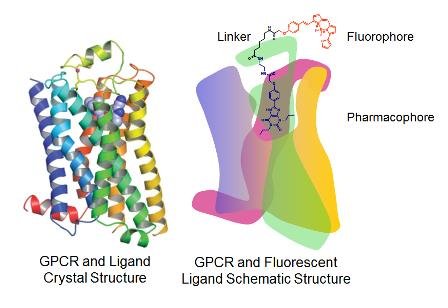Introducing the CellAura fluorescent ligand range

The CellAura range currently includes ligands that target GPCRs such as adenosine, dopamine, 5-HT, adrenergic, muscarinic and histamine receptors. View our full range of fluorescent ligands and caged tools.
What are CellAura fluorescent GPCR ligands?

- A pharmacophore - e.g. a synthetic agonist or antagonist
- A fluorescent dye (the fluorophore)
- A linker - which connects the pharmacophore with the dye
- Immediate ‘real time’ readout
- Visual confirmation of receptor localisation
- Multi-colour and multi-parameter data generation
- Miniaturisation capability (one cell per data point)
- No scintillation detection costs
- Enhanced safety with reduced costs - no radioisotope use and disposal
Applications
Each CellAura fluorescent ligand has been characterised using live cell imaging and functional analysis to confirm its affinity and pharmacological activity. They have been used successfully in a wide range of applications:
-
Fluorescent Ligand Binding: Increased safety, reduced disposal cost and environmental impact vs radioligand binding.
- High Content Screening: Live cell imaging of receptor-ligand binding, displacement, and receptor internalisation.
- Fluorescence Correlation Spectroscopy (FCS): Real-time analysis of single molecule ligand-receptor interactions.
- Fluorescence Activated Cell Sorting (FACS): No need to generate fluorescence-tagged antibodies - you can select receptor expressing cells using a direct receptor-binding ligand.
- Dual Readout Binding and Function (eg Ca2+ signalling): Distinguishes agonists, antagonists/inverse agonists, off-target effects and non-binders in one assay, to eliminate false hits and reduce follow-on screening.
- Confocal Microscopy: Localise receptor distribution in single cells, cell cultures and tissue sections.
- High Throughput Screening: Dynamic or endpoint binding and displacement Fluorescence Intensity assays.
- Receptor Dimerisation: FRET between two fluorophores using a common ‘warhead’ (homodimerisation) or two different ‘warheads’ (heterodimerisation).
- Ligand Binding Kinetics: Real-time analysis of ligand association and dissociation rates to determine receptor affinity.
- Allosteric Modulators: Kinetic measurements of allosteric modulator effects on ligand association and dissociation rate.
The CellAura range
The range includes ligands designed to selectively target GPCRs such as adenosine, dopamine, 5-HT, adrenergic, muscarinic and histamine receptors. Many have been cited in the scientific literature, and you can view the details of these publications on the product page for each ligand.
Examples include:
CA200634 CellAura fluorescent adenosine antagonist [XAC (HB7814)] is a competitive fluorescent adenosine receptor antagonist (with apparent KD values of 7.50, 7.37 and 7.30 for A2A, A3 and A1 respectively). It antagonizes the activity of NECA, an adenosine receptor agonist and exhibits no intrinsic agonist activity.
CA200623 CellAura fluorescent adenosine agonist [NECA] (HB7813) is a fluorescent adenosine receptor agonist (pEC50 values are 8.57, 8.47, 6.76 and 5.69 for A3, A1, A2A and A2B respectively), derived from the non-selective adenosine agonist NECA.
CA200843 CellAura fluorescent H3 antagonist [clobenpropit] (HB7826) is a fluorescent H3 histamine receptor antagonist (apparent KD values are 7.09, 6.55 and 5.71 for H3, H1 and H2 receptors respectively). It antagonizes the activity of histamine and displays no intrinsic activity.
>View the full range of CellAura ligands
Technical FAQs
For further information and technical support read fluorescent tools technical FAQs or download the pdf brochure Introducing CellAura Fluorescent Ligands.





![Binding of CA200623 CellAura fluorescent adenosine agonist [NECA] Binding of CA200623 CellAura fluorescent adenosine agonist [NECA]](https://cdn.hellobio.com/media/wysiwyg/Products/HB7813-CA200623-image1-fl_result.jpg)